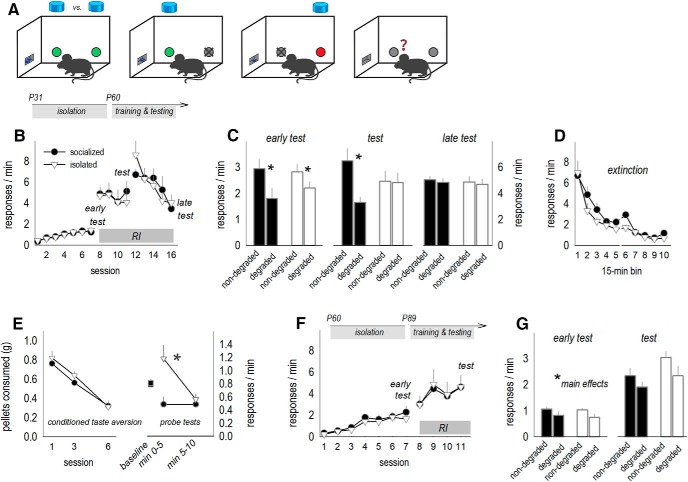Figure 3.
Social isolation in adolescence, but not adulthood, causes failures in instrumental response updating later in life. A, A task schematic is provided: An instrumental contingency degradation task was used as in Figure 2, except both nose pokes resulted in the same type of pellet (represented here as a blue pellet). B, Experimental timeline at top. Adult mice with a history of social housing or social isolation were trained to nose poke on two recesses for a single food reinforcer, with no group differences in response rates. Breaks in acquisition curves represent tests for sensitivity to instrumental contingency degradation. C, In an early test, all mice decreased responding when the instrumental relationship associated with that response was violated (degraded). As in Figure 2, however, previously isolated mice failed to update response strategies with additional training, deferring to habit-like behavior (test). In a late test following extended training, all mice developed habit-like strategies (non-specific responding) as expected. D, Response extinction was unaffected. The break in the x-axis represents the passage of 1 d (n = 12/group). E, In a separate experiment, we decreased reinforcer value by pairing the food reinforcers with LiCl. LiCl induced conditioned taste aversion, as indicated by less food consumed over the course of multiple pairing sessions (left). When placed in the conditioning chambers, previously socialized mice inhibited responding relative to their pre-aversion baseline (before LiCl). By contrast, previously isolated mice initially responding robustly despite diminished outcome value before ultimately inhibiting their responding (right; n = 10–11/group). F, Next, separate mice with a history of social isolation in adulthood were trained to nose poke for food reinforcers. G, Unlike mice with a history of social isolation during adolescence, mice with a history of social isolation during adulthood retained outcome-sensitive response strategies (n = 6/group). “Main effects” refers to main effects of response type, regardless of group (no interactions). Mean ± SEM, *p < 0.05.

